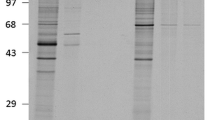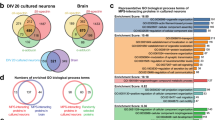Abstract
NEUROFILAMENTS ∼100 Å in diameter appear in electron micrographs to be major constituents of most nerve cells, but their function is not clear and their shapes vary1. In thin sections of brain they appear relatively thick and knobby1; whereas in negative stain, squid neurofilaments appear smooth and cylindrical2,3. Only neurofilaments from the squid giant axon3 and from calf brain4,5 have been isolated in quantities sufficient for analysis, but these differ in their solubility properties and subunit molecular weights. These inharmonius observations are partially clarified by the transformations reported here of neurofilaments from a new and nearly ideal source, the giant axon of a marine worm, Myxicola infundibulum.
Similar content being viewed by others
References
Wuerker, R. B., and Kirkpatrick, J. B., Int. Rev. Cytol., 33, 45–75 (1972).
Davison, P. F., and Taylor, E. W., J. gen. Physiol., 43, 801–823 (1960).
Huneeus, F. C., and Davison, P. F., J. molec. Biol., 52, 415–428 (1970).
Shelanski, M. L., Albert, S., De Vries, G. H., and Norton, W. T., Science, 174, 1242–1245 (1971).
Davison, P. F., and Winslow, B., J. Neurobiol., 5, 119–133 (1974).
Gilbert, D. S., Nature new Biol., 237, 195–198 (1972).
Day, W. A., and Gilbert, D. S., Biochim. biophys. Acta, 285, 503–506 (1972).
Maxfield, M., J. gen. Physiol., 37, 201–216 (1953).
Hodgkin, A. L., and Katz, B., J. exp. Biol., 26, 292–294 (1949).
Orrego, F., J. Neurochem., 18, 2249–2254 (1971).
Schlaepfer, W. W., Brain Res., 69, 203–215 (1974).
Hallpike, J. F., and Adams, C. W. M., Histochem. J., 2, 559–578 (1967).
Cajal, S. R., Degeneration and Regeneration of the Nervous System, 1, (Hafner, New York, 1959).
Boycott, B. B., Gray, E. G., and Guillery, R. W., Proc. R. Soc., B 154, 151–172 (1961).
Potter, H. D., and Hafner, G. S., J. comp. Neurol., 155, 409–423 (1974).
Weber, K., and Osborn, M., J. biol. Chem., 244, 4406–4412 (1969).
Gilbert, D. S., J. Physiol., Lond., (in the press).
Author information
Authors and Affiliations
Rights and permissions
About this article
Cite this article
GILBERT, D., NEWBY, B. & ANDERTON, B. Neurofilament disguise, destruction and discipline. Nature 256, 586–589 (1975). https://doi.org/10.1038/256586a0
Received:
Accepted:
Issue Date:
DOI: https://doi.org/10.1038/256586a0
- Springer Nature Limited
This article is cited by
-
Persyn, a member of the synuclein family, influences neurofilament network integrity
Nature Neuroscience (1998)
-
An immunocytochemical study of calpain II in the hippocampus of rats injected with kainate
Experimental Brain Research (1997)
-
Interrelationship between retinal ischaemic damage and turnover and metabolism of putative amino acid neurotransmitters, glutamate and GABA
Documenta Ophthalmologica (1992)
-
Immunological and chemical characterization of hamster brain polyribosomes-cytomatrix complexes
Neurochemical Research (1989)





